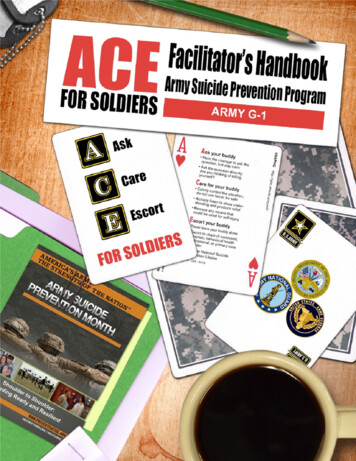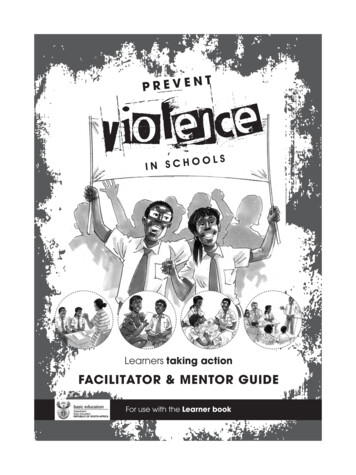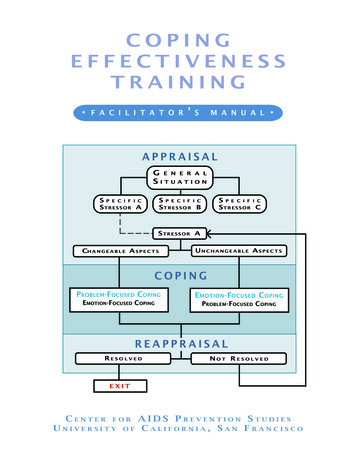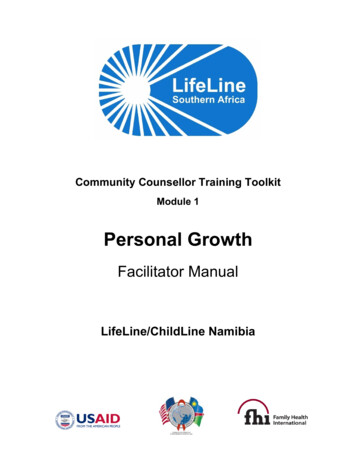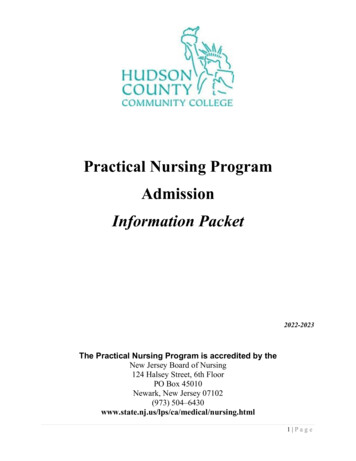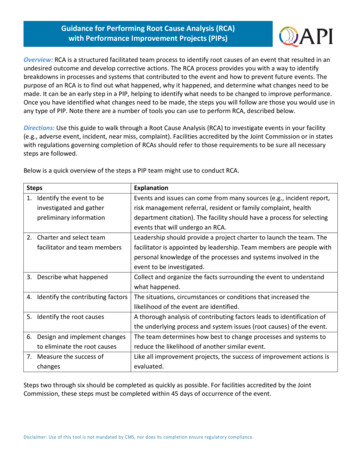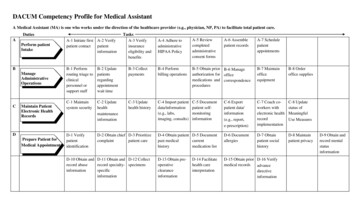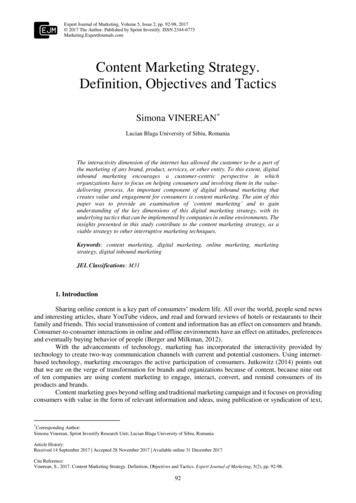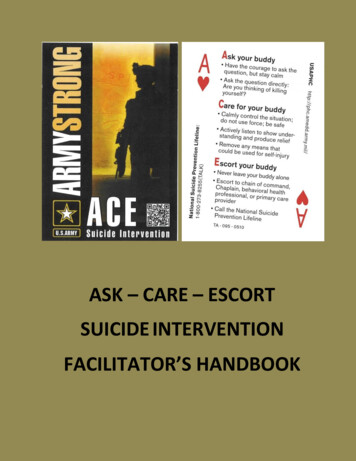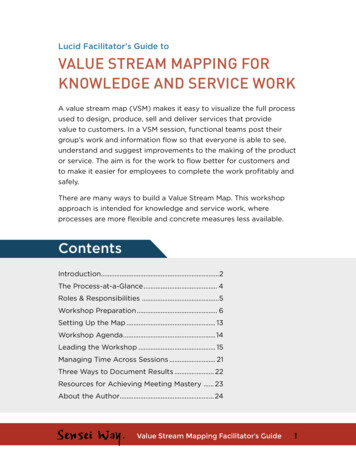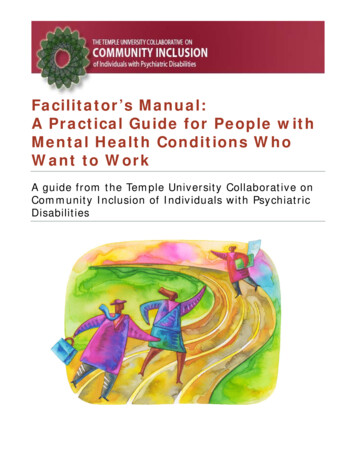
Transcription
Facilitator’s Manual:A Practical Guide for People withMental Health Conditions WhoWant to WorkA guide from the Temple University Collaborative onCommunity Inclusion of Individuals with PsychiatricDisabilities
IntroductionMost people with mental health conditions are unemployed and/orunderemployed even though many say that they want to work. It isthe purpose of the Practical Guide on Employment to provideinformation and encouragement about competitive employment, to demystify the process of going to work, and to help people know whatquestions to ask and what issues to consider so they can make goodwork-related decisions for themselves.The Practical Guide was designed primarily to be a self-help tool. Bythis, we mean that a person (or group of people) with a mental healthcondition would not necessarily need the assistance or involvement ofservice professionals in order to read and use the Guide. However,that doesn’t mean that people have to read or use the Guide alone. Aswith any other major undertaking, it can be helpful to have companyalong the way. It can be easier to take in new information or considerhard questions if there is someone to talk it over with, or who is on thesame journey.We offer this Facilitator’s Manual to help people – incommunity mental health centers, consumer self-helpprograms, or psychiatric rehabilitation services, for instance who want to develop structured and semi-structured ways touse the Guide with groups of people with a mental healthcondition who are considering work.Facilitators Manual for People with Mental Health Conditions Who Want to Work TempleCollaborative on Community Inclusion for Individuals with Psychiatric Disabilities 1
Please note that the Manual itself is intended only to be anintroduction and supporting resource for people who want to return towork, and is not a substitute for quality individualized vocationalrehabilitation services and counseling. It is our hope that thisaccompanying Facilitator’s Manual can help people use the Guide as anaide to thinking about, pursuing, and obtaining / maintainingcompetitive employment who want to do so within a group setting. Inthis Facilitator’s Manual we offer some suggestions, discussionquestions and additional sources of information which we hope will behelpful. The suggestions offered here are ideas, not formulas. You willhave to pick and choose, and make some decisions about what willbest serve your group. In most sections there are many suggestionsfor discussion topics and activities, and you probably won’t need to useall of them. Test out these ideas and strategies and also use your ownexperience and judgment. As you gain experience facilitating/leadinggroups, you will get better at knowing what will work, and you will getbetter at working without this Manual.This Manual is based upon an earlier work compiled and produced byKaren Escovitz and edited by Karen Escovitz and Richard Baron atMatrix Research Institute, with support from the National Institute onDisability and Rehabilitation Research. The current edition was editedand updated by Arlene Solomon, Horizon House, Inc., with thoughtfuleditorial contributions made by Susan Rogers, Director of the NationalMental Health Consumers’ Self-Help Clearinghouse, in Philadelphia.Formatting and editing were provided by Jared S. Pryor, TempleUniversity Collaborative; and graphics design were provided by Mariadel Mar Cabiya, Philadelphia Department of Behavioral Health &Intellectual Disability Services. Copies of the Facilitator’s Manual canbe downloaded from the Collaborative’s website at tucollaborative.org.Facilitators Manual for People with Mental Health Conditions Who Want to Work TempleCollaborative on Community Inclusion for Individuals with Psychiatric Disabilities 2
Some Defining Features of GroupsDrop-in Groups vs. Set Membership - With drop-in groups, people candrop in as they feel like it, or as they need to, and you will havedifferent participants at each meeting. With set membership groups,you have people sign up for the group, and have the same participantseach time. It can be hard to build on past information or groupexperience with drop-in groups, and hard to build relationships andcreate continuity. On the other hand, it also means that you may havefresh new perspectives each week, and it creates an open atmospherethat can feel welcoming to some participants. For others who maywant to develop a sense of safety and trust by meeting with the samegroup of people, a set membership group might be more comfortable.It is possible to set up a kind of compromise between these, in whichthere is set membership for a few weeks in which a particular topic iscovered, and then the group opens up again for new participants.Leadership StructureThere should be clarity about what sort of leadership structure yourgroup will have. Peer-led groups are groups in which the leader ororganizer is like the other group members in an important way (e.g.the leader is also a person in recovery). Participants often find it easierto open up and trust someone who shares their struggles. A groupmight also be organized or led by a person from a provider agencysuch as an employment specialist who may bring specific expertise orresources to the group. It is also possible to have a group where thereis no leader per se, and the group members set the agenda togetherand monitor how things are going.Facilitators Manual for People with Mental Health Conditions Who Want to Work TempleCollaborative on Community Inclusion for Individuals with Psychiatric Disabilities 3
Your group might have one kind of structure for the entire life of thegroup, or you might vary it meeting by meeting, depending on thetopic. For instance, you may want to bring in an outside expert for onesession to teach about Social Security benefits, but then have anothersession in which there is open discussion (with no leader) about jobsearch frustrations. It is important, however, that the participants inthe group understand whichever leadership structure is being used sothey know what to expect.Different Leadership FunctionsThere are different functions that can be important to the life andsuccess of the group. A leader might use these depending on thepurpose and needs of the group. It is possible for one person to beresponsible for more than one function, or you might consider splittingup these jobs among different people -- e.g. bring in a teacher fromoutside who has special expertise, have one person take care ofcoordinating tasks, and another attend to facilitating the groupattending to group process.Coordination: This means taking care of logistics like making surethere’s a space to meet, making sure that participants know when andwhere the group meets, refreshments, materials, etc. The personresponsible for coordination must be able to attend to details, and bereliable and consistent.Facilitation: Facilitation is about helping the group stay on topic,making sure everyone gets a chance to participate, making sure thatground rules are followed and that things are running smoothly. TheFacilitators Manual for People with Mental Health Conditions Who Want to Work TempleCollaborative on Community Inclusion for Individuals with Psychiatric Disabilities 4
person who is facilitating must attend to group process, fairness,safety and confidentiality. Being a good facilitator requires the abilityto pay close attention to what is happening, to participants’ feelings,and to whether the group’s ground rules are being followed.Teaching/Educating: The person who is responsible for thisfunction helps the group to understand the material and learn whatthey need to know. Being a good teacher / educator requires thoroughknowledge of the information or skills being taught, the ability toexplain and clarify things well, and the ability to be patient withpeople’s different learning styles and rates. Teachers / educators oftenneed to be able to role model or demonstrate the principles or skillsthat they are teaching.It is important, when deciding who will be providing these differentleadership functions, to make sure that each job is done by someonewho has the necessary skills or strengths. For instance, someone whois not good at dealing with details would not be the best choice tohandle the coordination responsibilities.The Life of the GroupAs you are getting started, give some thought to the life of the groupacross sessions. It is important to have a plan for how your group willgo. You will probably make adjustments to the plan as you go along,but you should start out with an idea that you think will be effectiveand helpful for the group participants.Facilitators Manual for People with Mental Health Conditions Who Want to Work TempleCollaborative on Community Inclusion for Individuals with Psychiatric Disabilities 5
The Purpose: make sure you define what your purpose is forgathering the group. Some possible purposes might be: to educateparticipants about the value and possibility of work, to shareinformation and strategies, to actually help people get jobs, to sharesupport while people are considering or pursuing jobs, to encourageparticipants to think about a productive future for themselves, etc. Youmay have more than one purpose. For that matter, your purpose maychange over time. Whatever you decide, you will need to be able totell people what to expect from the group. It is likely that the peoplewho attend most consistently will be those individuals who are mostclosely aligned with the purpose of the group. Defining your purposewill help you determine other characteristics such as how often tomeet, who you want to invite into the group, what leadership isneeded, etc.The Mechanics: it’s not difficult to set up a group. You need aspace to meet, a schedule (regular meeting times work best), a planfor how many times you will meet, and a way to let people know aboutit. When promoting the group, you should be clear about who isinvited to participate, what the purpose of the group is, and what thetime commitment will be so that people know what they’re signing upfor. Think about what time of day will work best for the people youexpect to participate in the group. Also, try to find a location that iseasy for people to get to.The First Session: when your group first starts to meet, you willneed to review the purpose and ground rules of the group and givepeople a chance to make a choice about whether they want to stay orleave. Put ground rules in place along with a plan for what will happenif someone breaks the rules. This might range from being remindedFacilitators Manual for People with Mental Health Conditions Who Want to Work TempleCollaborative on Community Inclusion for Individuals with Psychiatric Disabilities 6
about the rule, to being given a warning, to being asked to leave thegroup. It can be important to spend a little time getting to know eachother. Have members of the group introduce themselves and talk alittle bit about why they want to be in the group, or why they areinterested in working.Session by Session: it is important to pay attention to pacing.You will want to move through the material quickly enough thatparticipants don’t get bored, and slowly enough that most people arekeeping up with the group. After the first few meetings, you will get asense of how much your group can do in one meeting. If your grouptends to go off-topic, or if things are moving too slowly for you toaccomplish your planned agenda, you may have to decide whether tochange the agenda, or whether to take a more focused approach tothe material. If one issue keeps coming up, it may be an indicationthat participants want or need to talk about that issue. Decide whetherit makes sense to let that issue have a session of its own, or whetherit’s important to stick to your original plan.Winding Down: Make sure to end the group when you said youwould, unless you have made an agreement with the group tocontinue. Prepare participants a few weeks ahead of time and thencountdown to the end of the group. Make sure to leave some time tosummarize what the group has done/discussed and leave time to plannext steps both for the group and for individuals. If you didn’t cover allthe material you planned to or if the participants want to continue, it isbetter to start up another group than to extend the first one beyondthe stated time frame.Facilitators Manual for People with Mental Health Conditions Who Want to Work TempleCollaborative on Community Inclusion for Individuals with Psychiatric Disabilities 7
Ground RulesIt is important that expectations for behavior during the group areclear to all participants at the beginning of the group. You should planto review them in detail during the first group session. You may alsoneed to remind participants periodically about your ground rules. Therules you put in place in your group should be the minimum necessaryto ensure safety, privacy, and respect for all group members (includingthe facilitator!). Below are some ideas for ground rules. You may notneed all of these, or there may be other rules that are important toyour group.HousekeepingDefine your group’s purpose clearly, and agree to stick to that purposeduring group sessions. Remind participants that it is disrespectful ofother group members to impose outside agendas or issues into thegroup’s time. Example: “This group is convened for the purpose ofhelping all group members explore their interest in working.” Or “Thisis a job club in which all participants are actively seeking employmentand are helping / supporting each other in doing so.”Have a clear attendance policy. Example: “Group members areexpected to attend every week for the next 10 weeks. If someonemisses 3 meetings, they will be asked to leave this group and wait fora chance to participate in the next one.” Or “This is a drop-in group.Therefore, it is open to anyone from the community who has a mentalhealth diagnosis and is considering work. Participants may attend oneFacilitators Manual for People with Mental Health Conditions Who Want to Work TempleCollaborative on Community Inclusion for Individuals with Psychiatric Disabilities 8
session or as many as they see fit.” Decide what attendance policymakes sense for your group.Be clear about location, starting time and ending time, and stick to it.It is disrespectful of those who make sure to arrive on time if the starttime is delayed significantly for latecomers.Values and BehaviorsClarify the values that the group will share, and it will lead you toidentify expectations for the way that participants will behave andtreat each other. Below are some examples of values that the groupmay choose to share, and some ways that this can translate intoground rules for participation. Personal Responsibility.Make sure everyone understandswhat your responsibility is, and is not, as group leader or facilitator.Be prepared to meet that responsibility consistently. Articulate theresponsibilities of participants also. Example: “My job in the group isto keep us on topic, help make sure everyone gets a chance toparticipate, and to make sure the room is open on time, and lockedat the end of group.” and “Each participant is responsible for his orher own level of participation, attendance, for being on time and forcompleting ‘homework’ assignments.”Mutual Respect.Respect for peers is important. There aremany behavioral ground rules that may relate to conveying respect.For instance, decide what the group’s standards are regarding harshlanguage. Let people know that while disagreements are inevitable,personal attacks will not be tolerated. Interrupting can be acommon problem in groups, and you might also consider making aFacilitators Manual for People with Mental Health Conditions Who Want to Work TempleCollaborative on Community Inclusion for Individuals with Psychiatric Disabilities 9
rule about not interrupting other participants when they arespeaking. Depending on the group, there may be other types ofground rules that will help to maintain an atmosphere of respectsuch as how participants dress, how they address each other, etc. Right to Privacy. Equal Opportunity to Participate. Diversity is OK.Create clear expectations regardingprivacy. If your group is operating within an agency or organization,there may already be rules about confidentiality that the groupneeds to follow. However, even if the group is completelyindependent, participants need to know that their privacy will berespected. Example: “What and who is seen and heard in this groupstays here, within the group, and is not to be discussed outside ofthis group.” Or “It is ok to talk with others about the general issuesthat we discuss here, but do not ever share anyone else’s storywithout their permission.” Also, sometimes people ask for a phonelist of all group members. Decide as a group whether this is ok ornot.Everyone deservesopportunities to speak. Sharing group time or “air time” should beexpected of all members. Some may choose not to speak much, butthat doesn’t mean they are not benefiting from the group. It isimportant that individuals do not dominate the group’s time withtheir own personal issues. TIP: If one person is dominating thegroup, explore the possibility that this person may need additionalattention outside of the group so that his/her issues will notdominate group life. This can also be related to the issue of treatingeach other with respect.Acknowledge diversity within the group-whether visible or not. People will bring various life experiences tothe group, and will be at different levels educationally,occupationally, and in terms of their challenges. Avoid valuejudgments about people in the group and their uniquecharacteristics. Articulate that all experiences and questions arevalid and valuable material for the group, and that each participantFacilitators Manual for People with Mental Health Conditions Who Want to Work TempleCollaborative on Community Inclusion for Individuals with Psychiatric Disabilities 10
is entitled to her/his own opinion. TIP: It can be helpful to invitepeople to use “I” statements (telling about their own experiencesand/or opinions), rather than judging other people’s experiences oropinions.Structuring SessionsHere are some tips for running group sessions Start and end on time. Have a plan ahead of time for what you want to accomplish inyour session. Then structure the time in a way that will help youdo this. One common group technique is to have a “check-in” at thebeginning or at the end of the session. This can help peopletransition into the session and helps participants know each otherbetter. A typical check-in might be to respond to a question like:“How are you feeling today?” or “How was your week?”, “Whathave you been thinking about employment issues this week?” Or“What progress have you made in your job search this week?” An alternative is to have a check-in at the end of the session.Leave enough time for each person to be able to speak brieflyabout they felt about that day’s group. Open-ended discussions have a way of eating up a lot of time.This is fine, and sometimes is exactly what the group needs.However, if you are trying to teach information, it can help tosave the discussion for after you’ve covered the desired material. Try to pace the group slowly enough that most participants cankeep up, but quickly enough that things don’t get boring. If youhave someone who seems to want to move much faster or muchFacilitators Manual for People with Mental Health Conditions Who Want to Work TempleCollaborative on Community Inclusion for Individuals with Psychiatric Disabilities 11
slower than the rest of the group, it may be helpful to spend timewith that person outside of group, either giving them extra thingsto do or to help them catch up. If you let that one person’s needsdetermine the pace of the group, you run the risk that otherparticipants may be annoyed or come to resent that person. Pay attention to who is active and who tends to be quiet in yourgroup. Try to make room for the shy types by asking themquestions and offering opportunities for them to speak, but donot force them or embarrass them. One way to cover the Guidebook material is to have participantsread an assigned section (or part of one) prior to the start of thesession. Then each person can read at her or his own pace andyou can start your group activities based on the assumption thatyou share certain information. Participants might also be asked to prepare for a session ahead oftime by doing “homework” assignments (e.g. keeping a journal,cutting out want ads, drafting a cover letter, etc.) This can helpparticipants to stay engaged with the material in betweensessions, and can provide a springboard for group activities anddiscussion in the next session. If you do choose to give suchassignments, make sure the expectations are clear andunderstood by all participants.Please Note: Written material in the Guide may be difficult for somepeople to read or understand. Some sections may be harder thanothers. If participants are having difficulty it can help to read parts outloud in the group, and then discuss it together until everyone seems tounderstand the content. As facilitator, you should be prepared to helpexplain the material in the Guide to any participants who need it.Facilitators Manual for People with Mental Health Conditions Who Want to Work TempleCollaborative on Community Inclusion for Individuals with Psychiatric Disabilities 12
There are Different Options for Usingthe GuidebookYou may go through the materials section by section as a group onesection per week, or one at a time at whatever pace works for thegroupYou might want to use some, or all of the Guidebook as supplementalmaterials in a pre-existing group; to provide or add to information in apre-designed curriculum or as a special topic in a back-to-work group.For instance, if you have a peer support group already running andpeople have questions about job accommodations, you could providethe group with copies of Section 11 for discussion.You might use clusters from the Guide together for a period of a fewweeks at a time. Here’s one possible way to cluster the sections: Section 1, 2, 3 to explore values, hopes and fears about work; Section 4, 5 to address empowerment issues and assessinterests/goals; Section 6, 7, 8 for information and strategies for job hunting orfor use with people who are actively job hunting; Section 9, 10 to provide information about and discuss benefitsissues;Facilitators Manual for People with Mental Health Conditions Who Want to Work TempleCollaborative on Community Inclusion for Individuals with Psychiatric Disabilities 13
Section 11, 12 to talk about workplace rights; Section 13, 14, 15 with people starting jobs or already working tohelp maintain attachment to the workforce.In summary, you have a lot of choices to make and someplanning to do if you choose to use the Guidebook as a way toencourage individuals to return to competitive employment.Think carefully about your plans, discuss them with yourcolleagues and supervisors, ensure that the people who will beparticipating in the group have a range of choices about how thegroup will operate, and then enjoy the discussions!Facilitators Manual for People with Mental Health Conditions Who Want to Work TempleCollaborative on Community Inclusion for Individuals with Psychiatric Disabilities 14
Facilitator’s Guide for Section 1:An Introduction to MentalHealth Challenges and Work
Purposeof thisSectionGroupObjectivesSection 1 gives an overview of the Guide andvarious issues one might address in consideringwork. Some readers might find thisoverwhelming, but others will appreciate knowing Introducetopics/issues.the topics and having a sense of where things are Define terms.going. Get to knoweach other.SuggestedActivities Review the topics together and discuss howthey fit into your group’s schedule. Howmany times will you meet, and what will becovered each time? Identify together any topics that groupmembers are particularly interested in orworried about. This will help you plan futuresessions. Define the terms you will use as a group. Inparticular, figure out what term(s) to use forpeople living with mental health diagnoses(e.g., “consumer,” “person in recovery.”)Also, define together what your group willmean by “work.” (Part time or full time?Volunteer or paid? Temporary or
permanent?)SuggestedDiscussionQuestions Why have you chosen to participate in thisgroup at this time? What kind of work (if any) have you done inyour life? What role (if any) do you want work to havein your life? What would you like to get out of this groupexperience? Have you ever had a job you liked? Whatdid you like about it? Have you ever had a job you hated? Whatdid you hate about it? What changes do you hope working willmake in your life? What changes are you afraid working mightmake in your life? What work-related goals (if any) do youhave?Tips Start with the descriptive and/or positive.There will be plenty of time in upcominggroups to discuss barriers and difficulties. If this section corresponds with theFacilitators Manual for People with Mental Health Conditions Who Want to Work TempleCollaborative on Community Inclusion for Individuals with Psychiatric Disabilities 17
beginning of your group, address any“housekeeping” issues, such as the time andplace your group will meet, the number ofsessions, attendance expectations andground rules. It may be difficult to keep participants fromjumping ahead and seeking extendeddiscussion of particular topics. If thishappens, reassure participants that theseissues will be addressed as the groupprogresses.OutcomesBy the time you have finished covering Section1,group members should:a) understand the range of issues that will becovered by the Guide and/or by the groupover time, and know what to expect.b) have a shared set of terms that they canuse in future meetings.c) have begun to share with each other someof their thoughts and /or feelings aboutwork in their own lives.Facilitators Manual for People with Mental Health Conditions Who Want to Work TempleCollaborative on Community Inclusion for Individuals with Psychiatric Disabilities 18
Facilitator’s Guide for Section 2:The Importance of Work
Purposeof thisSectionGroupObjectivesSection 2 introduces some of the potentialadvantages of working, and reviews some of theevidence that work is a realistic possibility for the Explore themajority of persons with mental healthadvantages ofdiagnoses. It provides encouragement and tipsworking.for starting to make decisions about work. Develop a senseof the possibilitySuggestedof working.Activities Identify sourcesof support. Take some firststeps together. Review the advantages of working listed inthis section. Brainstorm about otherpotential benefits of working. Present some information about people withmental health diagnoses who havesucceeded at working. Include informationabout both famous and ordinary people andvarious types of jobs. Invite a few employed individuals to talk toyour group about why and how they decidedto begin to work or return to work, whatthey get out of it, how they knew it waspossible, and what helped them keep theirjobs. Review the “How to Get Started” strategiesin this section. Point out that participantsalready have an advantage because ofhaving the group as a source ofFacilitators Manual for People with Mental Health Conditions Who Want to Work TempleCollaborative on Community Inclusion for Individuals with Psychiatric Disabilities 20
support/information. Ask group members todo one thing from the list of “how to getstarted” suggestions between this meetingand the next one. Suggest some websitesfor people to visit and report back about. Provide information about local employmentresources. Invite participants to share anyinformation, programs, agencies andcounselors that have helped them withemployment. Help each participant identify specific peoplewith whom they could discuss their ideasand aspirations about work. These could befamily members, peers, counselors, clergy,etc., and should be chosen for theirwillingness to support the participant inmaking his/her own choices about work. Inaddition, group members might discuss howthey could rely on one another for suchsupport.SuggestedDiscussionQuestions What advantages of working are mostimportant to you? Why? Do you think it’s possible for you to work?Why/why not? What would make it possible?Talk about any job experiences that weresuccessful and why they were successful. Do you know anyone with a mental healthdiagnosis who works? What kind of work dothey do? What are their hours? Did they getthe job themselves or did anFacilitators Manual for People with Mental Health Conditions Who Want to Work TempleCollaborative on Community Inclusion for Individuals with Psychiatric Disabilities 21
agency/program help? Does the employerprovide any accommodations for the personbased on his/her disability? (The point is tocommunicate both the possibility of workingand the diversity of jobs, arrangements,etc.) Do you feel discouraged or hopeful aboutworking? Why? Where/from whom do youget messages about whether or not youcould or should work?Tips It is important for the facilitator to help finda balance between two popular but opposingbeliefs: first, that work is difficult oroverwhelming; and, second, that work willbe wonderful and solve all of a person’sproblems. Discuss work in terms that areboth realistic and encouraging. Participants will probably bring up theirspecific concerns. Some group membersmay have tried to work and lost or left ajob. Some may have been told that theycouldn’t or shouldn’t try. Some might feeldiscouraged and hopeless. Participants maybe afraid that if they try, the
Facilitators Manual for People with Mental Health Conditions Who Want to Work Temple Collaborative on Community Inclusion for Individuals with Psychiatric Disabilities 3 Some Defining Features of Groups Drop-in Groups vs. Set Membership - With drop-in groups, people can drop in as they feel like it, or as they need to, and you will have
